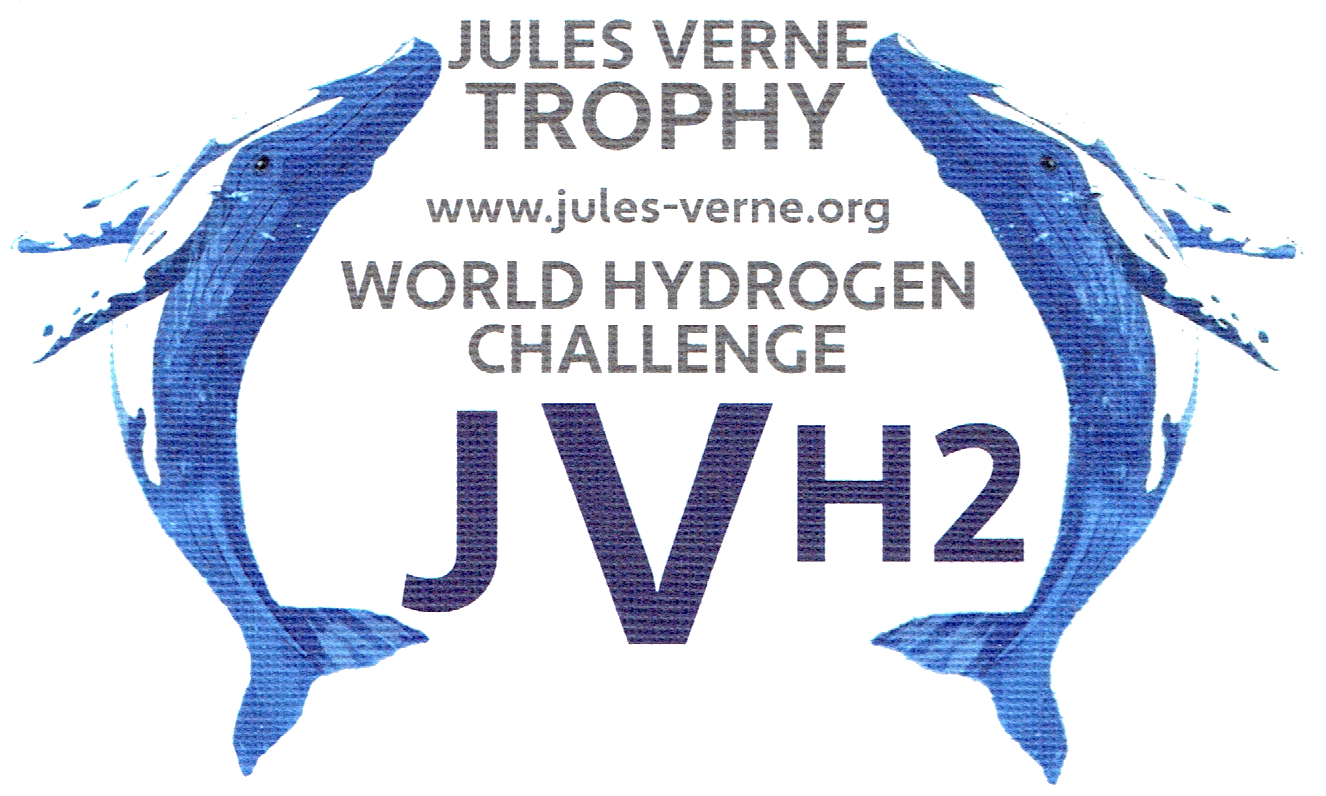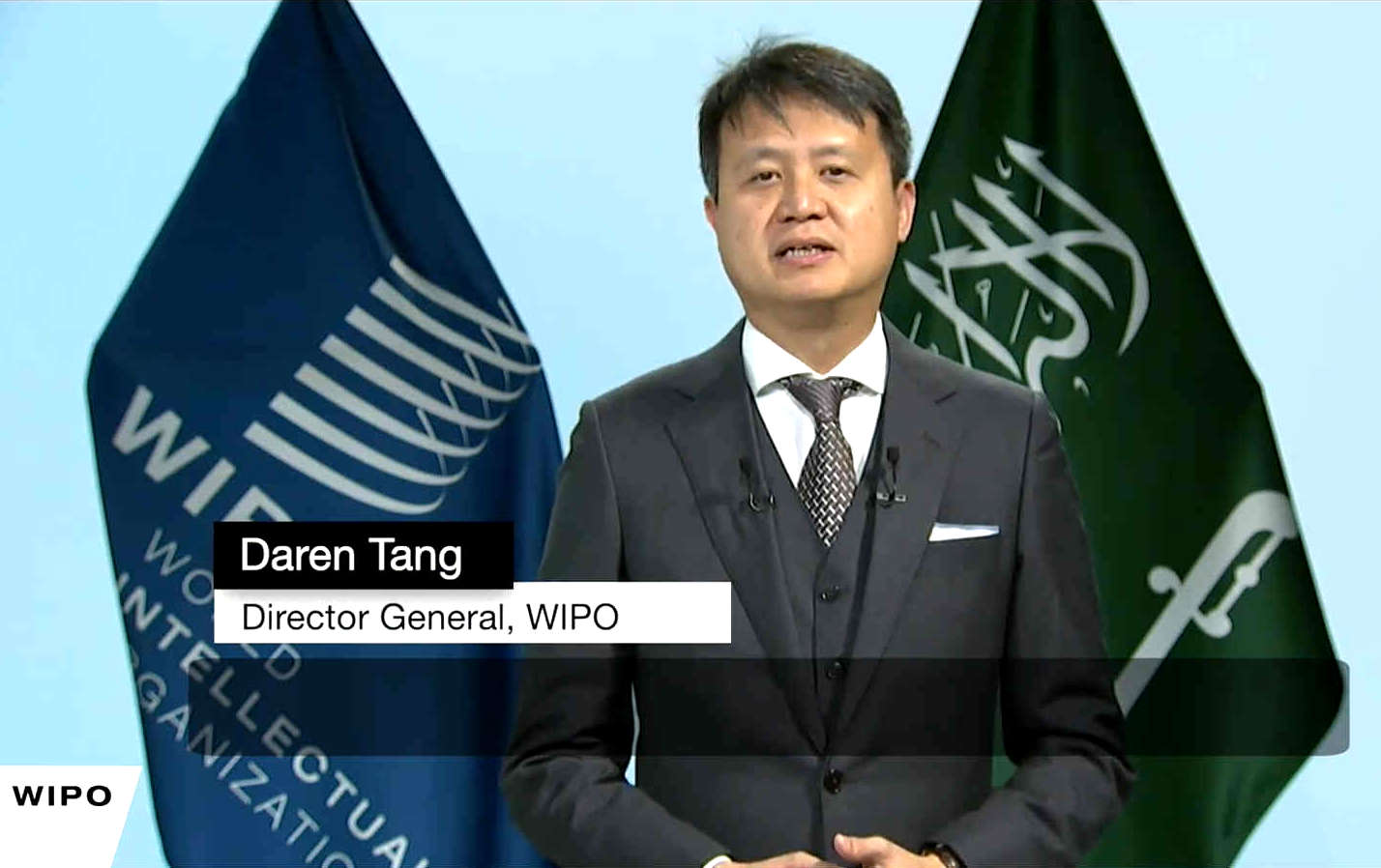|
WHAT
IS A PATENT AND WHY BOTHER?
Patents
protect a product or service. The unreasonably high fees for
international protection and the lack of state prosecution for those who
violate granted rights, makes inventors wonder why it's worth the bother
and expense of telling everyone how your invention works.
Though,
stealing someone's idea, when it is patented or trademarked, constitutes
fraud. However, when one such case was reported to the police in Sussex,
and they said it was a civil matter. Yet, fraud is fraud.
Not
only that, but the very limited lifespan of a patent, of just 20 years, means that by
the time you have a product or process perfected for production, there
is not much time left to recover your investment.
Then
there is plagiarism. Once you have revealed how your system works, there
is nothing to stop others from copying your work. Then you face years of
painful litigation from high powered concerns like car and energy
companies, who will do all they can to bury you with legal costs as the
chosen weapon. As they walk off with your technology. There are many
such true stories.

IP
HERO - Regarded by many as a modern hero, for taking on the giants, even
at great personal cost. He lost his family and very nearly his sanity.
But, he will be remembered by every innovator who comes up against
corporate big business, Since the caselaw he created is there for all to
cite. Our advice though, is choose another way of earning a living. Let
the morally unsound stew in their own juices.
Ford said they had not stolen Kearns’ idea. His patent was invalid on the grounds that it wasn’t “sufficiently inventive.” They said he'd used off the shelf parts. The Jury disagreed, the parts were used in an innovative way that was not obvious. Or, Ford would have thought of it before Bulldog Bob. Everything seems obvious, once you know the answer.
Coming up with a solution first, is the inventive step. Ford and other
auto makers did not have a clue as to how Robert's invention worked.
ROBERT
W. KEARNS - AN OBJECT LESSON OF HOW THE PRESENT SYSTEM
DISADVANTAGES INVENTORS
On a rainy day in 1962, Robert Kearns had one of those meandering thoughts that separate great inventors from mere mortals: What if a windshield wiper paused between each wipe, like a blinking eye?
He constructed prototypes in his basement, filed a patent, and began to dream up a plan: He’d set up a pretty little factory in Detroit, become a major supplier of windshield wipers, and go down in history as one of the automobile industry’s great innovators.
THEN FORD STOLE HIS IDEA
Corporations
will steal if they can. It's a sad fact of life. Why they don't just pay
reasonable royalties is a mystery. And the public don't seem to care
that someone was cheated. They keep buying Ford
(and other) cars.
In 1969, Ford debuted a fancy, first-of-its-kind intermittent windshield wiper on its line of Mercury cars.
The wipers, which cost Ford $10 to make and sold for $37, were a hot commodity and were soon adopted by others in the auto industry: By the mid-1970s, Chrysler, General Motors, Saab,
Honda, Volvo,
Rolls-Royce,
Mercedes and dozens of other big-name brands had a version of intermittent wipers on their cars.
All mimicked the exact configuration of Kearns’ device.
For nearly 30 years, Kearns waged an impossible legal battle against one of America’s most powerful companies. In the end, he won millions of dollars — but it cost him his sanity, his marriage, and the remaining years of his life.
Kearns’ story is remembered as one of history’s great David vs. Goliath lawsuits. But it’s also a reminder of the shortcomings of the US
(all) patent system(s) for independent inventors.
In January of 1990, Robert W. Kearns, a former professor at Wayne State University in Detroit, won his patent infringement suit against Ford on Monday in federal court.
He has filed similar suits against General Motors Corp., Chrysler Corp., Daimler-Benz, Honda, Toyota, Nissan and 21 other companies. The Ford case was the first to go to trial.
Kearns said in his 12-year-old lawsuit that his version of intermittent windshield wipers was unique because of a certain combination of parts. Ford denied that.
An eight-member jury sided with Kearns after a week of deliberations. Chrysler was ordered to pay Kearns US$18.7 million with interest. Chrysler appealed the court decision, but the Federal Circuit let the judgment stand. The Supreme Court declined to hear the case. By 1995, after spending over US$10 million in legal fees, Kearns received approximately US$30 million in compensation for Chrysler's patent infringement.
As Kearns waged this slow, agonizing war, his case became less about financial compensation and more about calling out big corporations for stealing intellectual property from inventors.
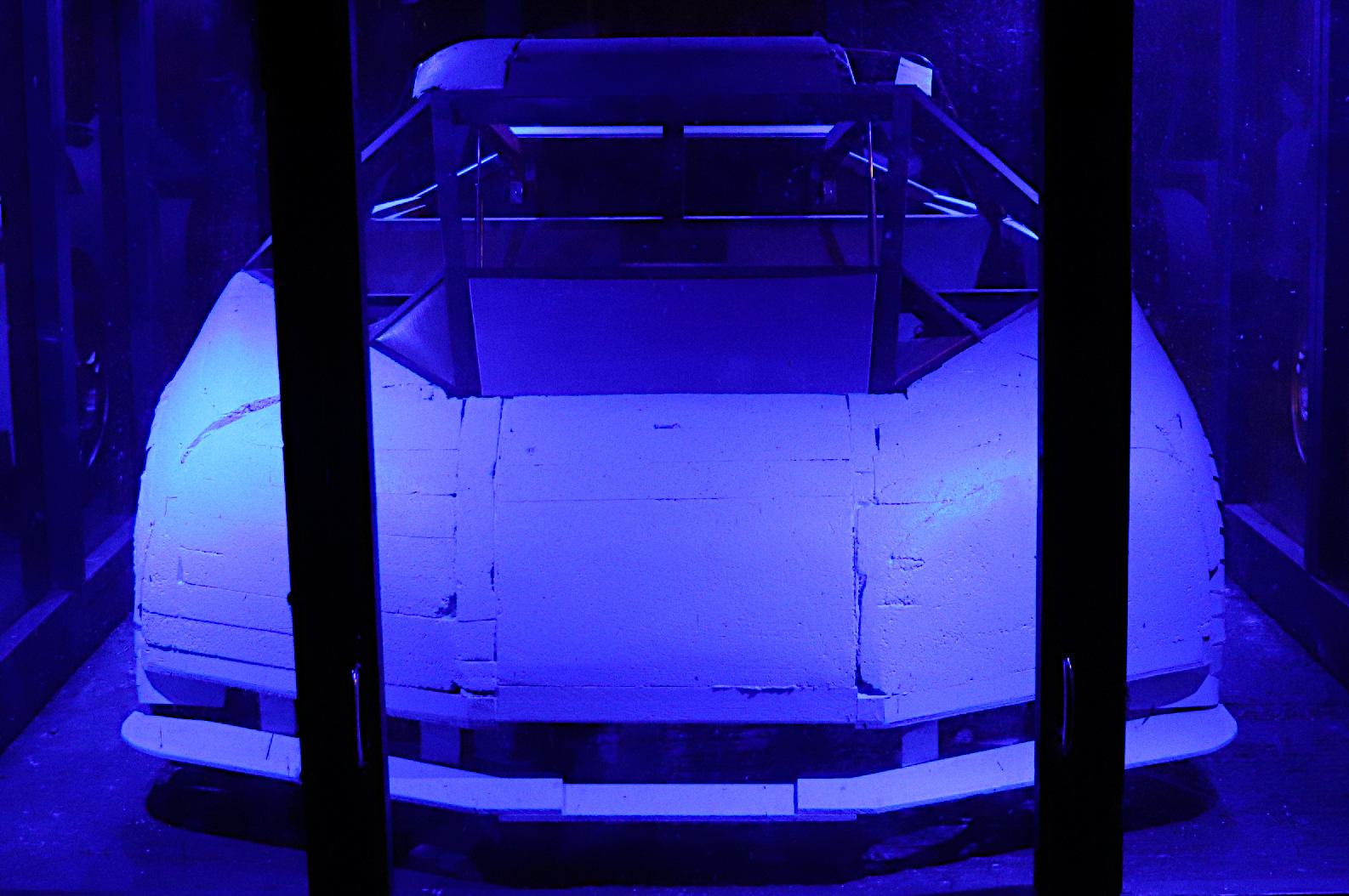
PATENTS
- This hand built prototype vehicle contains a lot of proprietary
know-how that may never be revealed. Designs may
also be registered, and copyright utilised to protect some elements of chassis layout,
cartridge and loader design, etc., etc. As the 'Robert Kearns case amply
demonstrates, the patent system is woefully inadequate for lone
innovators. Students with no previous
experience helped to build this custom car, now on display at a private
museum in Sussex, England - though not yet open to the public. The
students were not involved in the high-tech stuff. Just the basics of
vehicle design, woodworking, shaping and welding. So preserving the IP
for fairer times. Until then, vehicle and infrastructure development
will limp along. Unless, you want to enter a JVH2 world hydrogen
challenge, and help to change the world.
KEEP
IT TO YOURSELF - OR RISK BEING EMBITTERED
For
struggling inventors, we'd suggest not telling anyone about your designs
or processes. Not until someone is prepared to pay you for your time in
development. In Europe, under their Horizon scheme, it might pay to
engage in collaborative research, where patent fees in part may qualify
for funding. But beware, decisions on funding are very political, and
ideas could be plundered by unscrupulous examiners and passed on to
other favored applicants - as the decision making process is conducted
in complete secrecy - and there is no compensation scheme in existence.
Examiners names are withheld, etc., and you have no access right to
their files. Where corruption in the EU and other nations
is not contained, nor is the decision making process, or results of applications
transparent. As in who was awarded the monies you applied for. Why risk
it?
BRAIN
DRAIN
Governments
need new technology, so that big business can sell new products which
generate taxes. If big companies had to pay inventors for their ideas,
the flow of new products to market would slow, and with it taxes for
governments who usually overspend, with high national debts as proof of
ineptitude in balancing the books. Thus, officials encourage inventors
to file patents, knowing the little guy will lose out and get ripped
off. It's a wonderful system for extracting ideas from novices and the
less enlightened. As it stands.
HOW
MIGHT THE 'JVH2' HELP?
The
JVH2 is a challenge, or series of challenges, where your product or
process is not revealed to any third party. You don't need a patent to
enter, but your idea will receive press attentions, to help you market
your invention or innovative designs. We operate a 100% transparent
system, where you have access to your files. And the names of other
competitors are made known as part of the PR drive. But not how their
technology works.
We'd
suggest not telling anyone how your idea works. Or, get a signed
agreement in place, and only with persons who can be trusted. Obviously,
not with your competition, or anyone who might suffer loss from
disruptive technology.
JVH2
challenges are there to help inventors and entrepreneurs, without taking
anything away from their achievement. Indeed, you will receive a trophy as
if you had applied for patent protection and a Certificate. Plus, use of the appropriate
trade names, as may be applicable. These being granted free.
Details
of your solution will not be published. Whereas, carefully guarded
videos (your own), etc., will advertise your efforts.
The current
patent legislation in the UK is the Copyright, Designs and Patents Act 1988. You can find out more about copyright legislation by visiting the Intellectual Property
Offices (websites) in your country, or the WIPO, international World
Intellectual Property Organization.
We
are of the view that green
patents should be free of fees, like copyright,
and that the state should enforce against infringement. Or, that
applications are free, with low cost infringement insurance guaranteed
by the state. We have lobbied for change. So far being given the cold
shoulder. Until such time as the law is updated to protect newcomers, be
very careful not to reveal the spark that makes your idea work, where
others have failed.
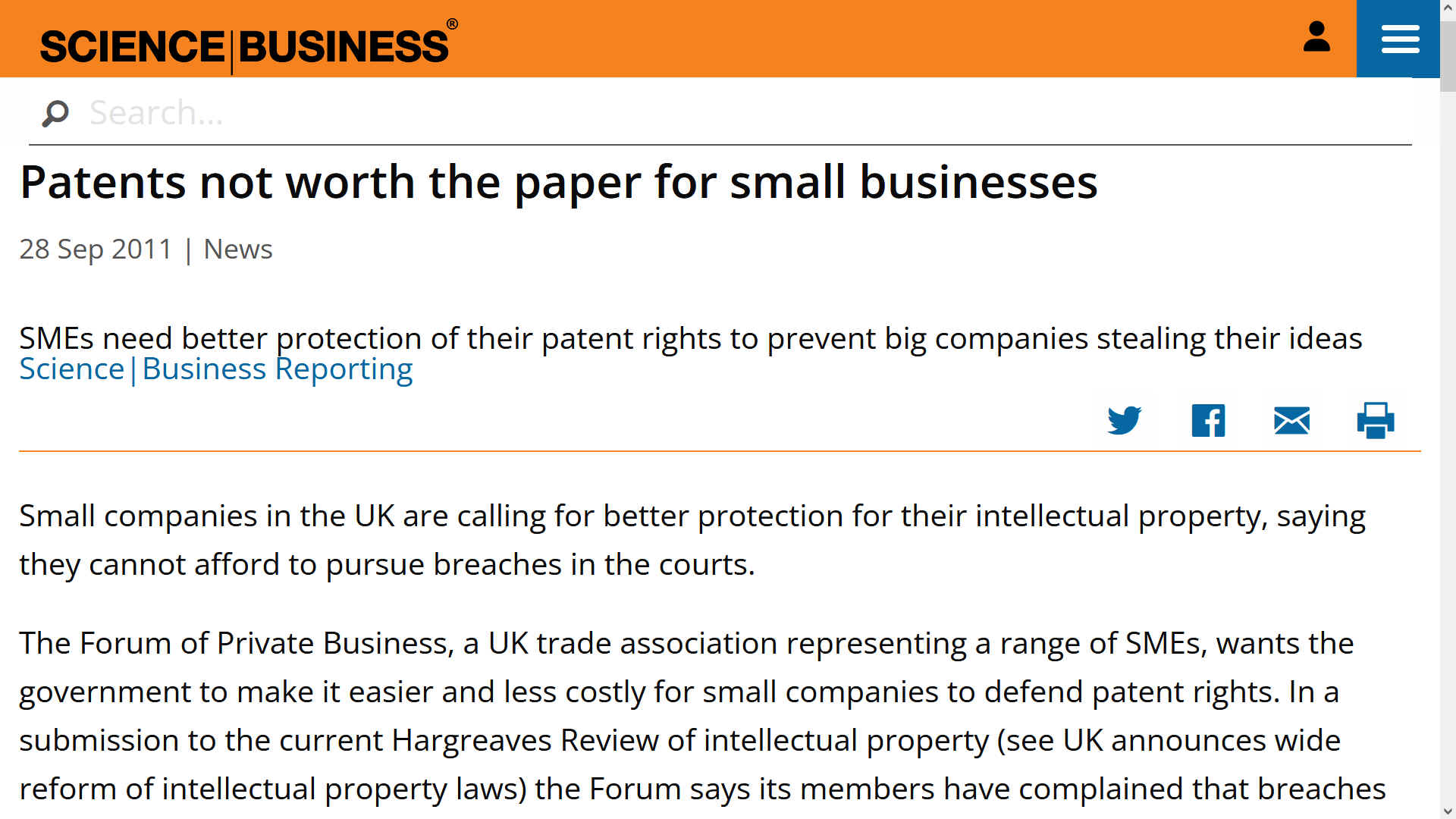
SCIENCE BUSINESS 28 SEPTEMBER 2011 - PATENTS NOT WORTH THE PAPER FOR SMALL BUSINESSES
SMEs need better protection of their patent rights to prevent big companies stealing their ideas.
Small companies in the UK are calling for better protection for their intellectual property, saying they cannot afford to pursue breaches in the courts.
The Forum of Private Business, a UK trade association representing a range of SMEs, wants the government to make it easier and less costly for small companies to defend patent rights. In a submission to the current Hargreaves Review of intellectual property (see UK announces wide reform of intellectual property laws) the Forum says its members have complained that breaches are going unpunished because of the steep costs involved in pursuing them in court.
In addition, the Forum says innovations are often manufactured under license outside the EU – with significant transfer of knowledge abroad, but no control over how it is used.
One Forum member John Collier of Monument Tools Ltd in Wallington, Surrey, has developed a new type of pipe cutting tool. Its biggest market is in the US but he has experienced a number of patent and IP problems involving bigger companies bringing in similar products he believes should be protected designs. “There have been cases where we’ve had IP protection but importers just ignore it,” said Collier. “The tool is made in Asia, for example, put into the UK market and then they sit there waiting to be sued – in the full knowledge that small businesses can’t afford to sue them.”
Collier added, “There’s nothing you can do about it because you can’t afford to – they are the big company and you are not. “
In addition to steep litigation fees, the Forum is concerned that patent costs, a lack of clarity over R&D tax credits and a lack of support within the UK’s public procurement process are combining to hinder innovation-led growth.
“Entrepreneurs are the UK’s real innovators and this innovation is one of the key elements that we need to nurture to drive economic recovery and growth,” said Alex Jackman, Senior Policy Adviser at the Forum.
While several of the measures outlined in the Hargreaves Review are welcome, SMEs will remain at a disadvantage when it comes to protecting IP. “Specifically, we want small business owners to be able to secure their intellectual property more efficiently and cost-effectively, including through greater overseas protection of UK patents and IP,” Jackman said.
Patents
might as well be printed on toilet rolls, to at least have some use, as
you flush your money down the pan.
WHY
NOT WRITE TO YOUR GOVERNMENT ASKING FOR CHANGES IN THE LAW
Offering inventors what appears to be temporary exclusivity incentivizes them to invest in research and development, fostering innovation. But such protections are fake. There is no exclusivity where it is not possible to gain protections from the courts against imitators. Simply because the cost of getting to court is prohibitive. Thus, beyond the means of the ordinary inventor.
The fight against IP theft is ongoing, and governments, international organizations, and legal systems are constantly adapting to address these challenges. The existing system tricks creatives into giving access to their ideas, for the benefit of large corporations, all the while using the pretence of protection to drain ideas from their creators.
Steal them, and ruin them if they complain.
PROPOSED
LETTER: URGENT ACTION NEEDED TO PROTECT LONE INVENTORS FOSTERING
INNOVATION
Dear Minister/Secretary of State,
I am writing to express my deep concern about the significant challenges faced by lone inventors in the UK, particularly in light of the limited protection available and the high barriers to entry in the market. This situation discourages many budding entrepreneurs from disclosing their inventions, potentially hindering innovation and economic growth.
As you may know, lone inventors often lack the financial resources and legal expertise to navigate the complex patent system. The high costs associated with filing and enforcing patents can be insurmountable, leaving them vulnerable to exploitation and unable to secure fair rewards for their ideas. This discourages many from pursuing formal protection, opting instead for secrecy or even abandoning their inventions altogether.
Furthermore, the current market landscape presents significant challenges for lone inventors. The dominance of established players and the difficulty in accessing funding and distribution channels can make it extremely difficult for them to bring their innovations to market, even with strong intellectual property protection.
This situation creates a significant disincentive for knowledge sharing and collaboration, hindering the potential for groundbreaking discoveries and advancements. It also raises ethical concerns, as the lack of protection can leave inventors vulnerable to unfair appropriation of their ideas, potentially stifling their creativity and motivation.
Therefore, I urge you to take immediate action to address these critical issues and create a more supportive environment for lone inventors.
HERE
ARE SOME SPECIFIC RECOMMENDATIONS:
- Establish a grant program: Provide financial assistance to help inventors cover the costs of filing and enforcing patents, particularly for those with promising innovations in areas of public benefit.
-
Simplify the patent process: Streamline procedures and reduce administrative burdens to make the patent system more accessible and affordable for individual inventors.
-
Strengthen enforcement mechanisms: Increase resources and improve collaboration with international partners to combat patent infringement and ensure effective legal recourse for inventors.
-
Promote alternative reward systems: Explore alternative mechanisms like prizes, tax breaks, and public-private partnerships to incentivize invention and knowledge sharing beyond traditional patents.
-
Support knowledge-sharing platforms: Facilitate the creation of platforms that connect inventors with potential partners, investors, and resources, fostering collaboration and accelerating innovation.
By taking these steps, we can create an environment where lone inventors feel empowered to share their knowledge, pursue their ideas, and contribute meaningfully to our economy and society. I believe that fostering a culture of innovation is essential for our nation's future, and I urge you to prioritize the needs of lone inventors in your policy decisions.
Thank you for your time and consideration. I look forward to hearing your response and working together to find solutions that support and empower the next generation of innovators.
Sincerely,
[Your Name]
SUBJECT: A CALL FOR "GREEN PATENTS": FOSTERING INNOVATION FOR A SUSTAINABLE FUTURE
Dear Minister/British Representatives at WIPO,
We are writing to you today to propose a bold initiative aimed at accelerating the development and deployment of green technologies critical for mitigating climate change: the creation of "Green Patents."
THE CHALLENGE:
As we face the escalating threat of global warming, the need for innovative solutions has never been greater. However, the current patent system often presents significant barriers for inventors developing environmentally friendly technologies. High filing and enforcement fees, coupled with the standard 20-year lifespan that starts ticking immediately upon filing, can discourage inventors and hinder the commercialization of essential green inventions.
THE GREEN PATENT SOLUTION:
We propose the establishment of a "Green Patent" program with the following key features:
- Reduced or waived fees: Eliminate or significantly reduce filing and enforcement fees for patents on inventions with demonstrably positive environmental impacts.
- Extended protection: Grant longer patent terms for Green Patents, with the 20-year clock starting only when the invention is demonstrably adopted by the market. This incentivizes inventors to focus on commercialization while ensuring adequate reward for their efforts.
- Clear and objective criteria: Establish transparent and rigorous criteria for identifying and qualifying inventions for Green Patent status, ensuring the program's effectiveness and environmental focus.
BENEFITS:
By implementing Green Patents, we can expect several positive outcomes:
- Increased innovation: Reduced financial barriers will encourage inventors to pursue green technologies, leading to a wider range of solutions.
- Faster commercialization: Extended protection will incentivize inventors to focus on bringing their inventions to market, accelerating their impact.
- Enhanced global collaboration: International adoption of Green Patents can foster knowledge sharing and collaboration, accelerating progress towards a sustainable future.
UK'S LEADERSHIP:
The UK, with its commitment to climate action and its global influence, is uniquely positioned to champion Green Patents. By taking the lead in implementing this program and advocating for its adoption at WIPO, the UK can demonstrate its commitment to a sustainable future and inspire other nations to follow suit.
A CALL TO ACTION:
We urge you to seriously consider the Green Patent proposal and work towards its implementation. We believe this initiative has the potential to be a game-changer in the fight against climate change, and we stand ready to support your efforts in any way possible.
Thank you for your time and consideration. We look forward to your positive response and to collaborating on this critical initiative.
Sincerely,
[Your Name/Organization]
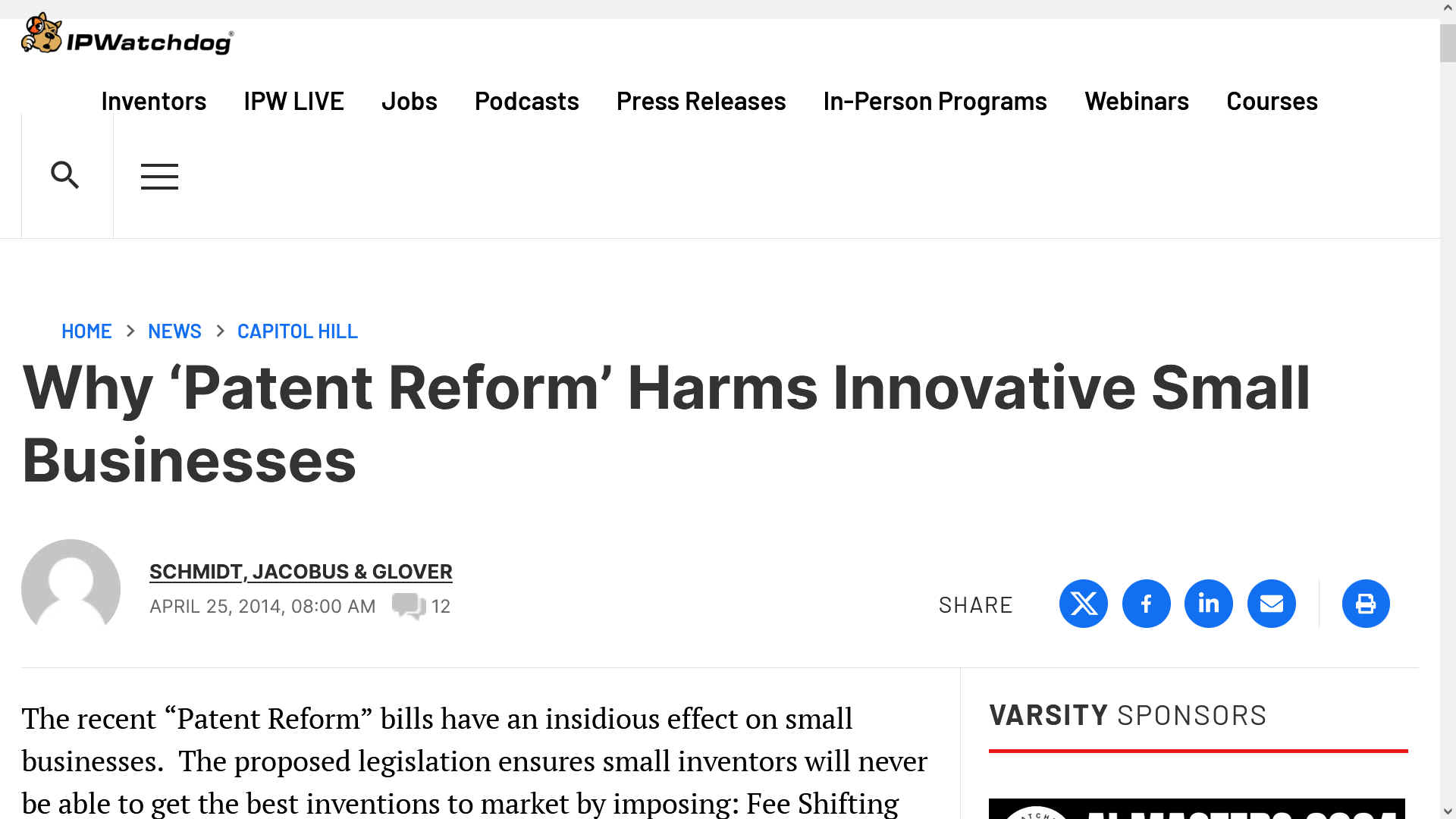
IP WATCHDOG 25 APRIL 2014 - WHY 'PATENT REFORM' HARMS INNOVATIVE SMALL BUSINESSES
The recent “Patent Reform” bills have an insidious effect on small businesses. The proposed legislation ensures small inventors will never be able to get the best inventions to market by imposing: Fee Shifting “Joinder”, Loser Pays, Pay to Play, Covered Business Methods (CBM), Elimination of Post Grant Review Estoppel, Disclosure of All Plaintiff Interested Parties, Enhanced Pleadings and Limiting Discovery, and Customer Stay provisions that are so onerous, only large corporations will be able to commercialize inventions. The provisions will make small inventing companies “Toxic Assets” to investors. Small inventors will likely need at least $5 million in the bank, not for their own use, but to cover the infringers’ costs. This is part of the shift in Congress to cater to big money interests, leaving the middle class behind. The details of these legislative “potholes” will be explained in this five part series.
As the National Co-Chairs and Executive Director of the Small Business Technology Council (SBTC), a council of the National Small Business Association, we support the highly inventive firms that participate in the Small Business Innovation Research (SBIR) and Small Business Technology Transfer (STTR) programs. The SBTC is a council of the National Small Business Association (NSBA), the nation’s first small-business advocacy organization, advocating on behalf of America’s entrepreneurs. A staunchly nonpartisan organization, NSBA’s 65,000 members represent every state and every industry in the U.S.
Small business creates about 5 times more patents per employee than large firms and 20 times more than
universities. [i] The SBIR program delivers 58% more patents than all U.S. universities
combined. [ii] Furthermore, small firms patents are more important (more often cited) than large firm
patents. [iii]
Small technology firms employ 38% of all scientists and engineers in America (54.8 percent of all industrial scientists and engineers). Yet these nearly 6 million scientists and engineers work with only 4.3 percent of the government R&D dollars. In contrast, firms with more than 500 employees account for only 27% of all scientists and engineers, but receive 50.3 percent of government R&D funds. Universities employ 16% of the scientists and engineers and receive 35.3 percent, non-profit research institutions 9.1 percent of R&D funding, and states and foreign countries 1.0 percent of R&D
funds. [iv]
The Small Business Technology Council (SBTC) believes that HR 3309 and other “patent reform” bills in the Senate will cloud patent titles, making them weaker. For small business, patents will become mostly unenforceable due to the proposed much higher upfront cost of litigation, thus making small business patents significantly less valuable. Loss of patent value constricts new company formation, chilling new investments, and choking job formation. Legislating disincentives for capital investments will result in the loss of many hundreds of billions of dollars of wealth in America and dry up the major source of new jobs, small inventing businesses. Purporting to attack predatory trolls, the bills instead attack all small companies with legitimate patent suits to protect the interests of large infringers at the expense of new business job creation. Furthermore, these bills do not specifically define or address “trolls” or “non-practicing entities,” but instead lump all patent holders together. With the current patent legislation, we have a baby and bathwater problem, we are “throwing out” our small business inventors.
HR 3309 (“Innovation Act of 2013”) is anti-innovation and anti-job, and will further raise the barriers against small business technology development by making it yet harder to win and defend a patent in the U.S. The House and Senate bills raise the costs of obtaining and defending new patents, which disproportionately empowers the largest firms while straining the capability of smaller firms. Intellectual property is a key component to make and keep good jobs in America. By raising the barriers to development and protection of intellectual property, the bills remove a key incentive to innovate, and provide large international manufacturers the ability to infringe with impunity. Patents protect U.S. jobs, and these bills are anti-patent and anti-job.
- By making it much easier for large integrated multi-national corporations to simply adopt new technology without consideration for patents, the resulting jobs will tend to flow overseas to the lowest-labor-cost location, rather than be held by U.S. workers defended by U.S. patents. U.S. patents are a primary defense keeping U.S. jobs in the U.S.
- Over time, these changes also reduce the incentives for American small businesses to continue their valuable innovation if their products can no longer be defended against appropriation by the large manufacturers. Small businesses create and tend to keep their jobs in the U.S.
Furthermore, the bills do nothing to help reverse the most pressing need at the US Patent and Trademark Office (USPTO), Fee Diversion. Over $1.7 Billion of patent fees has been withheld by the
Treasury. [v] As the patent office is self-funded using fees collected from inventors, withholding acts as a tax. Thus, this “Invention Tax” is a $1.7 Billion disincentive for invention in America. Even more importantly, since the withheld fees are not being used to modernize the USPTO technology or hire new examiners of the highest caliber to provide faster, better reviews, pendency remains near record
highs, [vi] which delays issuance of patents. This in turn retards corporate formation and funding, slowing the economy.
The U.S. innovation sector is responsible for 27.7 percent of U.S. jobs and 34.8 percent of U.S. GDP.[vii] According to David Kappos, the former head of the United States Patent and Trademark office, when discussing the lack of focus on Trolls in the current bills, “untargeted legislation puts in jeopardy U.S. technology
leadership.” [viii]
Patents are the number one indicator of regional wealth according to the Federal Reserve Bank.[ix] Where do the best patents come from? “SBIR-nurtured firms consistently account for a quarter of all U.S. R&D 100 Award
winners,” [x] on 2.5% of the Federal R&D budget. Regions that increase their number of patents gain $4,300 more per worker over a decade’s
time. [xi] If these “Patent Reform” bills are signed into law, they will discourage small business patents, and the contrapositive indicates that we will be a poorer nation. Changes in the law will also adversely affect the over 21,300 SBIR award winners and their over 112,550
patents. [xii] This will become even more critical over time as there has been a shifting in engineering talent from large businesses to small businesses. (The employment share of American small business engineers grew from 6% in 1978 to 38% in
2005. [xiii])
The Small Business Administration’s Office of Advocacy has now warned what these bills will do to the
economy. [xiv] This is despite the fact that HR 3309 overwhelmingly (325-91) passed the House, and the President’s indication, including comments in the SOTU
address, [xv] that he will sign a patent reform bill (such as HR 3309).
The President’s statements are inconsistent and appear to be at odds with his prior goals and statements, such as:
“President Obama has said, if we are to win the future and be successful in an increasingly competitive international market, the United States of America must innovate. … The Obama Administration’s determination to promote innovation and protect intellectual property (IP) rights will harness the inherent drive and ingenuity of the American people in meeting that goal. … Innovation protected by IP rights is key to creating new jobs and growing exports. … Protecting our ideas and IP promotes innovative, open, and competitive markets, and helps ensure that the U.S. private sector remains America’s innovation engine.” [xvi]
The America Invents Act (AIA) was fully implemented about 1 ½ years ago, and its effect on our patent system has yet to be fully understood. One of the AIA’s requirements was to have a study performed by the Chief Counsel for Advocacy of the SBA on the effects of the Act on small
business. [xvii] This report was to have been completed by September 16, 2012, eighteen months ago. We are very concerned that the Administration needs to be cautious before making additional changes to our patent laws, before the effects of the prior law have been evaluated.
We must be certain that changes that are made should not undermine incentives for developing new U.S. patents, their robust enforcement, or the existing economic incentives for companies of all sizes to invest in research, development, and new jobs. We encourage the Administration to request the Senate to hold additional hearings on the many different aspects of the legislation and its effects on small businesses.
And how many lives it has destroyed, or how many inventors have been
bankrupted?
The current Senate bills and HR 3309 have many items that we are concerned about. These include but are not limited to:
- Loser Pays.
- Pay to Play.
- Fee Shifting “Joinder”.
- Covered Business Methods (CBM).
- Elimination of Post Grant Review Estoppel.
- Disclosure of All Plaintiff Interested Parties.
- Enhanced Pleadings and Limiting Discovery.
- Customer Stays.
LOSER PAYS
American laws do not apply “loser pays” provisions to consumers, corporations, protected groups, or any other class of private litigants. This would induce these groups to tend to decline to enforce their legal rights. Why should inventors be singled out (as discrimination) as the only class so onerous that inventors alone should face this burden, when it applies to no one else? The result will be that small inventors will be deterred from exercising their rights and that invention and resulting jobs will dwindle. More perniciously, the smaller firms will be further deterred from investing to develop such rights, as they will need a $5-10 million legal war-chest before they try to exercise any patents. The large multi-national companies know that smaller companies cannot afford to pay the larger business’s legal costs if they lose, and so small businesses will not take the chance. In contrast, the larger business can afford the risk. This is anti-small business, anti-technology development, and anti-US jobs.
PAY TO PLAY
Pay to Play provisions require the inventor plaintiff to post a bond or certify that they can pay the alleged infringers legal fees should they not prevail. This puts enforcing a patent beyond the financial capability of all but the largest of small businesses. Patent litigation is already very expensive, highly risky and skewed unfairly in the favor of the infringer. Pay to Play will make almost all of the over 5,000 active SBIR companies lose most of their value, without any hope of being able to enforce their patents unless they give up the majority of their equity to a larger company (which would then put them out of the SBIR program).
FEE SHIFTING "JOINDER"
Fee Shifting “Joinder” makes investors and others personally liable for the legal fees of the alleged infringer if the plaintiff does not prevail (possibly on each and every claim). This provision eliminates a basic tenant of corporate law, protecting investors from personal liability, making patents a “toxic” asset.
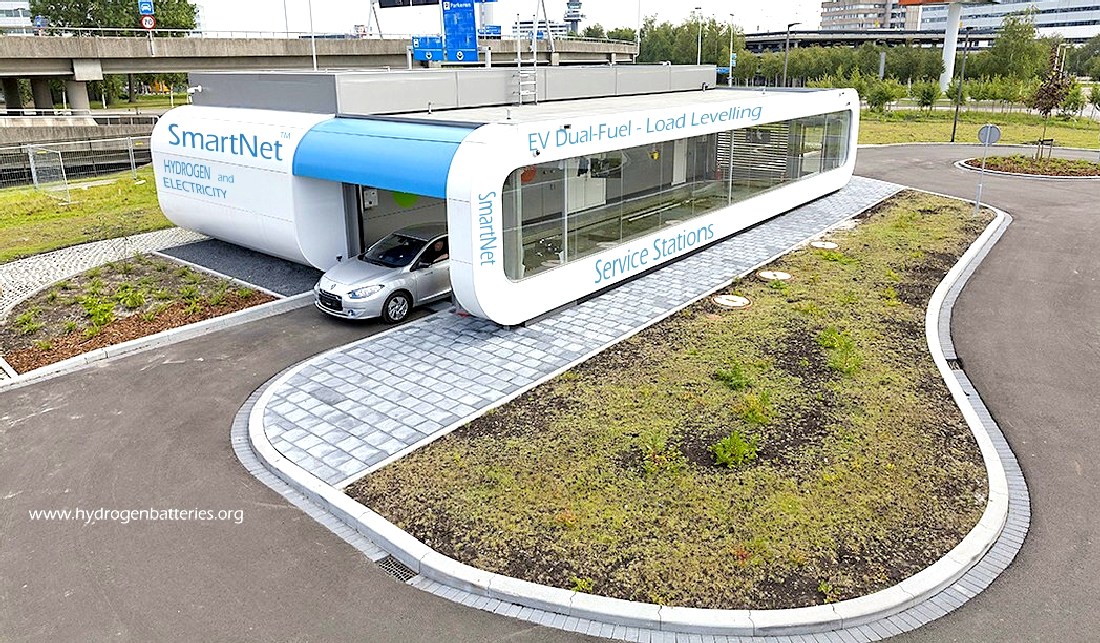
INVESTOR
NIGHTMARE
- This is an example of an investment nightmare. The market needs the
solution it provides, but there are no genuine patent protections. Not
even legislation forcing utilities and automotive OEMs to work together
to provide any kind of solution, that might in some measure incentivise
backers. Any such venture would end in tears, the asset being toxic.
Even worse of course, in the good old US of A. Not sure what the 'A'
stands for? It's not 'Liberty,' that's for sure.
TOXIC
ASSETS
Why would investors risk personal assets beyond what is directly invested in a business? This provision is antagonistic to investment in new technologies. With no investment, this is fatal to most inventors. Why are inventing companies now so heinous that America would revise corporate law to eliminate personal liability protections
- only for patent holders? What have inventors done to be singled out as to not be deserving of the personal liability protections that all other Americans receive. Is it in America’s interest to so persecute its inventors, investors, and entrepreneurs?
The conclusion must be that US policy makers are in the pockets of big business. Why else would any administration even consider imposing such burdens, when they should be levelling the playing field.
Clearly, if you are not absolutely loaded, it is not worth filing a patent in the USA, and it is not worth doing business with any US company, unless they are willing to sign agreements up front, in lieu of doing business, with a bond in default. Such that litigations costs will be covered by the defaulting company. The Robert Kearns case is the case precedent, that demands
equality at arms for the underdogs in this unfolding drama. In the UK is
is called a Fair Hearing, an Article 6 requirement under the Human
Rights Act 1998. Under the UN's Universal
Declaration, it is seen in Articles 7, 8 and 10. That being the
case, US patent law appears to be in violation of international law:
Article
7.
All are equal before the law and are entitled without any discrimination to equal protection of the law. All are entitled to equal protection against any discrimination in violation of this Declaration and against any incitement to such discrimination.
Article
8.
Everyone has the right to an effective remedy by the competent national tribunals for acts violating the fundamental rights granted him by the constitution or by law.
Article
10.
Everyone is entitled in full equality to a fair and public hearing by an independent and impartial tribunal, in the determination of his rights and obligations and of any criminal charge against him.
https://ipwatchdog.com/2014/04/25/why-patent-reform-harms-innovative-small-businesses/id=49260/
https://sciencebusiness.net/news/75460/Patents-not-worth-the-paper-for-small-businesses

|
